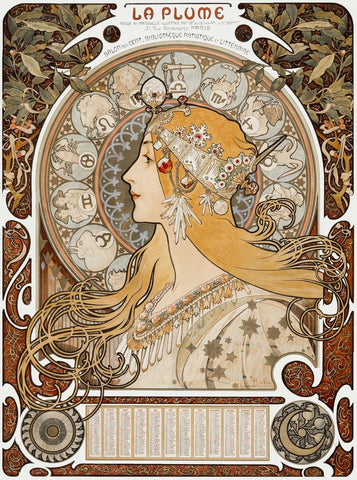
How to Choose the Right Vintage Wall Art for Me
Share
Selecting vintage wall art that resonates with your personal style and complements your home decor can be a delightful journey through history. If you're currently exploring the rich artistic eras of the 1890s to 1930s, you'll discover a treasure trove of styles and movements, each offering a unique aesthetic and cultural significance. This guide will help you navigate through the various art movements of this period, including Art Nouveau, Art Deco, poster art, and abstract art, and introduce you to some of the famous artists who defined these times.
Art Nouveau (1890s-1910)
(Tap image for more art nouveau prints)
Characteristics
Art Nouveau emerged as a reaction against the academic art of the 19th century. It is characterized by its use of long, sinuous lines, natural forms, and organic shapes. This style often incorporates floral motifs, curving lines, and elegant, flowing designs that mimic natural elements. Art Nouveau was not just limited to paintings; it encompassed architecture, furniture, and decorative arts.
Famous Artist: Alphonse Mucha
Alphonse Mucha, a Czech artist, is perhaps one of the most renowned figures of the Art Nouveau movement. Mucha's work is instantly recognizable for its beautiful, ethereal women set against ornate, floral backgrounds. His posters and advertisements, particularly those for the actress Sarah Bernhardt, are iconic examples of Art Nouveau vintage poster artwork.
Art Deco (1920s-1930s)
(Tap image for more art deco prints)
Characteristics
Art Deco, a stark contrast to the organic nature of Art Nouveau, is known for its bold geometric shapes, rich colors, and lavish ornamentation. This style reflects the modernization of the era, with influences from industrialization and the Machine Age. Art Deco is synonymous with luxury, glamor, and exuberance, making it a popular choice for vintage wall decor.
Famous Artist: George Barbier
George Barbier, a French illustrator, was a key figure in the Art Deco movement. His illustrations, known for their elegance and sophistication, often depicted high society and fashion. Barbier's work in fashion illustrations, book designs, and theater costumes showcases the distinct style and flair of Art Deco.
Poster Art (Late 19th Century - Early 20th Century)
(Tap image for more vintage poster art prints)
Characteristics
The late 19th and early 20th centuries saw a boom in poster art, thanks in part to advancements in printing technology. This era's posters were not just advertisements but also works of art, often featuring bold typography, striking colors, and compelling imagery. Vintage poster artwork from this period includes advertisements, travel posters, and event announcements.
Famous Artist: Leonetto Cappiello
Leonetto Cappiello, an Italian and French poster art designer, is often referred to as the 'father of modern advertising' because of his innovative approach to poster design. His posters are known for their vibrant colors, caricature-like figures, and the ability to capture the essence of the product or event being advertised.
Abstract Art (Early 20th Century)
(Tap image for more abstract prints)
Characteristics
Abstract art breaks away from traditional representation of physical objects. It emphasizes the use of shapes, colors, forms, and gestural marks to achieve its effect. This movement was a radical departure from the artistic norms of the time, focusing more on emotional expression and the exploration of color and form.
Famous Artist: Wassily Kandinsky
Wassily Kandinsky is often credited with painting one of the first recognized purely abstract works. His art is known for its vibrant colors and fluid forms, which aimed to convey spiritual and emotional experiences. Kandinsky's work is a brilliant example of how abstract art can evoke feelings and ideas in a way that traditional art cannot.
Choosing Vintage Wall Art for Your Home
When selecting vintage wall art, consider the following:
Personal Style and Home Decor
Your choice of vintage artwork should reflect your personal style and complement your home's existing decor. Whether you prefer the elegant lines of Art Nouveau, the bold geometry of Art Deco, the eye-catching appeal of vintage poster artwork, or the emotional expression of abstract art, ensure that your selection resonates with you personally.
Vintage Art Prints and Vintage Framed Posters
Consider the presentation of your art. Vintage art prints and vintage framed posters can add a touch of authenticity and character to your space. Think about frame styles and colors that will enhance the artwork and fit in with your room's aesthetics.
Vintage Wall Accents and Retro Wall Decor
Incorporate your vintage art into a broader theme of retro wall decor. Use your artwork as a starting point and add vintage wall accents like antique mirrors, clocks, or decorative pieces to create a cohesive look.
Placement and Arrangement
The placement of your vintage wall art can significantly impact its effect. Consider creating a vintage art wall as a focal point in a room, or distribute pieces throughout your home for a consistent theme. The way you arrange your art - whether symmetrically for a more formal look or asymmetrically for a casual feel - will also influence the overall impact.
In conclusion, choosing the right vintage wall art for your home involves understanding the different artistic movements and styles of the 1890s-1930s, as well as considering your personal taste and the decor of your home. Whether you're drawn to the elegance of Alphonse Mucha's Art Nouveau designs, the sophistication of George Barbier's Art Deco illustrations, the boldness of Leonetto Cappiello's poster art, or the expressiveness of Wassily Kandinsky's abstract works, there's a wealth of vintage artwork waiting to enrich your living space. Embrace the history and beauty of these art movements, and let your vintage wall art be a reflection of your unique style and the timeless allure of the past.







